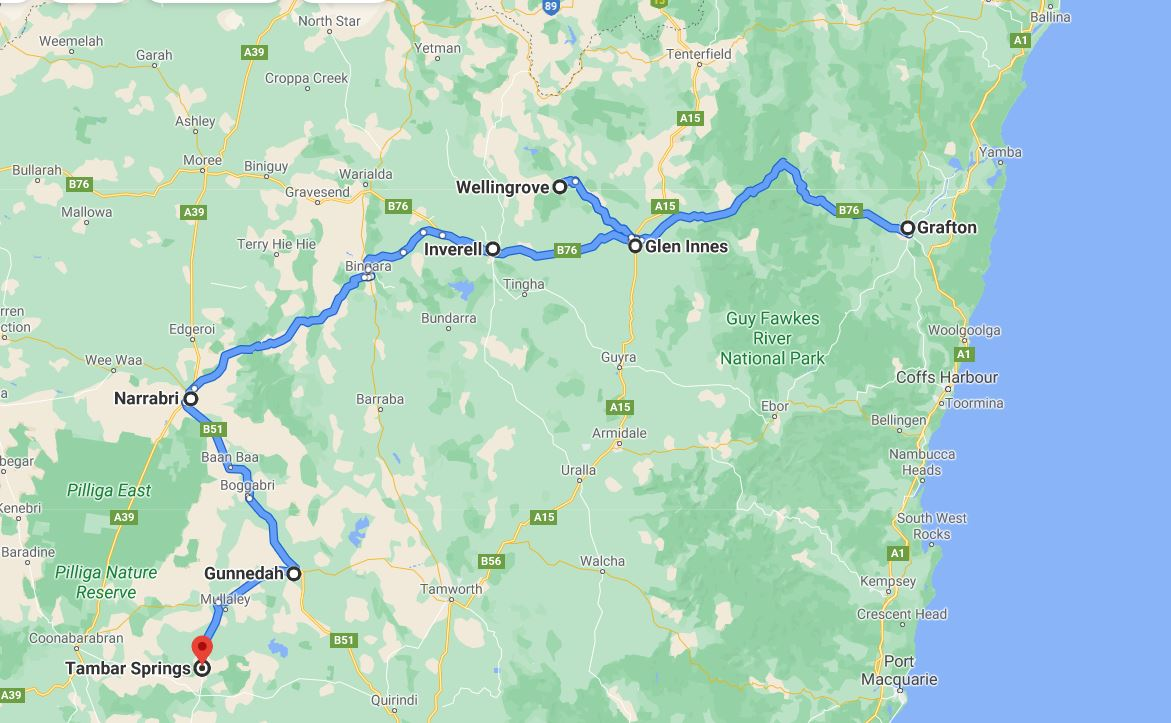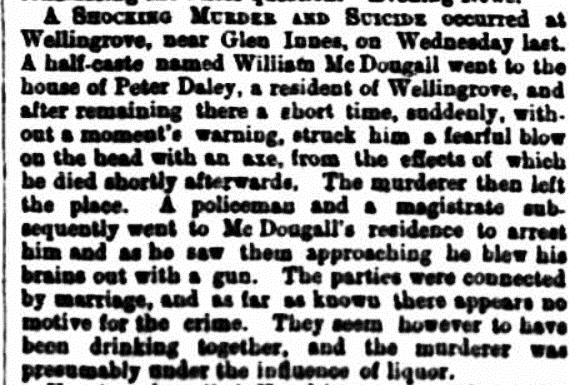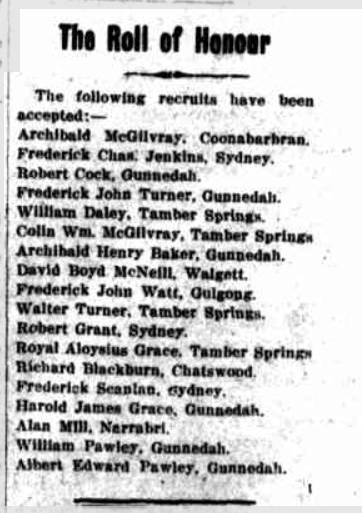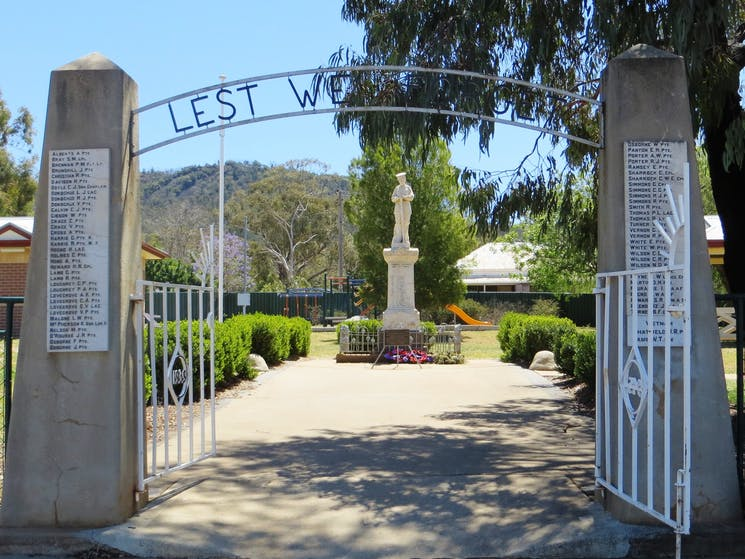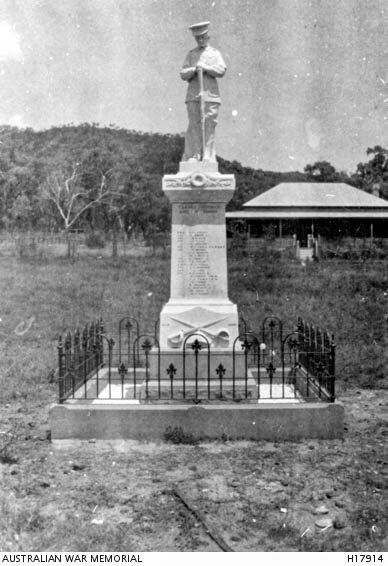William DALEY
Eyes brown, Hair black, Complexion dark
William Daley - Killed in Action
We believe that William Daley is one of many indigenous young men who volunteered to serve in the AIF in the first World War. His life is largely undocumented – sadly common in the colonial and early federation records reflecting the lack of recognition by authorities of our indigenous people. What little we know of William’s life is thanks to researchers and historians in groups like the Indigenous Histories project and others who are seeking to support Australian indigenous history, art, and culture. We thank them all for their invaluable help.
William Daley, a boundary rider at Tambar Springs and unmarried, enlisted in August 1915 in Narrabri in north-western New South Wales and less than a year later he was killed at Fromelles in France.
On enlistment, 3636 Private Daley was allocated to the 18th Battalion (8th reinforcements), underwent training in Sydney and embarked for Egypt in December on board HMAT A60 Aeneas. Shortly after arriving in Egypt, he was hospitalised in Cairo with mumps for the whole of February 1916. On discharge from hospital, William was transferred to the 54th Battalion leaving for France in June.
As noted by the Australian War Memorial, “the 54th fought its first major battle on the Western Front at Fromelles, on 19 July. It was a disaster. The 54th was part of the initial assault and suffered casualties equivalent to 65 per cent of its fighting strength.”
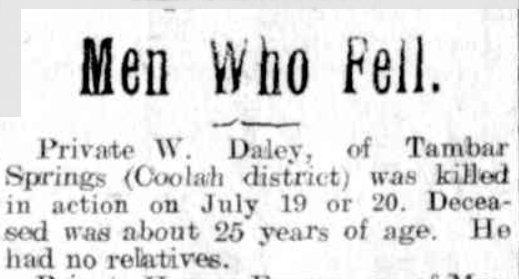
William was one of those casualties with his file showing that that he was killed in action on the evening of 19/20 July 1916. No other details are known and, unusually, there are no Red Cross enquiries into his death. Unlike many of the casualties, it seems a finding about William’s fate was made quite early in the aftermath of the battle with next of kin advised in early August 1916 that he had been killed. For many families, the delay in a formal finding was sometimes up to a year leaving them to deal with great uncertainty and anguish.
William Daley – A largely undocumented life
Researchers believe William Daley was born in about February 1887 in the Glenn Innes area of New South Wales as he gave his age on enlistment as 28 years and 6 months and identified as being of the Church of England faith. These enlistment records are possibly the only official records of William’s life. The first extract below gives William’s details on enlistment while the second shows William’s signature on his original application to enlist – possibly the only record of his handwriting.
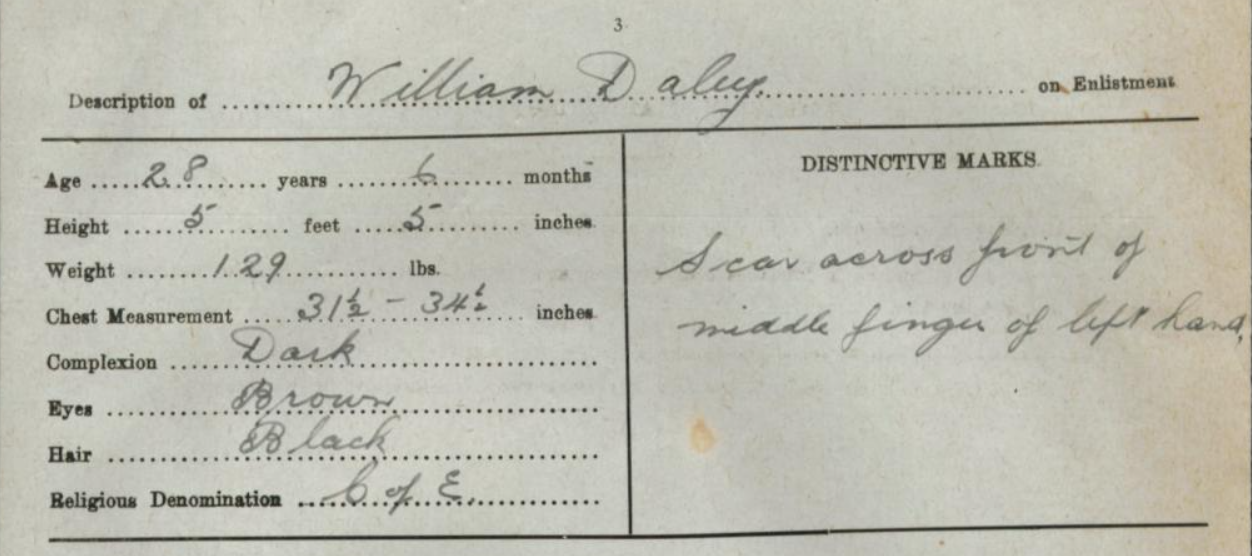

A range of evidence supports the view that William was of indigenous heritage. For many indigenous people of William’s era there is no official or other type of birth record. They were often not included in government civil registration records but may have been included in records for Protection or Welfare boards, church missions or other institutions tasked with caring and managing the indigenous population of New South Wales at that time. We have yet to identify birth or formal schooling records for William, but indigenous project researchers have been invaluable in identifying William’s family through their sources.
We have also pieced together information from William’s military records, newspaper and other records, and from indigenous researchers that have helped identify tiny snippets of his life, family and friends. Many of the life events identified occurred in the north-western parts of New South Wales and the map below helps identify relevant localities.
William’s family
William’s parents are believed to be as follows:
His mother: Ellen Harrison born in Wellingrove in the 1840s or 1850s to a tribal indigenous woman, Kate or Lena Robinson (abt 1830-68) and a former convict Henry Harrison (1816-1913) originally from Warwickshire. Ellen was the eldest of three Harrison children.
His father: Peter “Paddy” Daley (b1833-1887), an English-born miner from Grafton.
If William was born in February 1887 as indicated on his enlistment, he would be the youngest of seven children born to Ellen and Paddy – perhaps even born not long after his father’s death. Tragically, Peter Daley was murdered in an altercation on 19 January 1887 and is buried on Wellingrove station. Newspapers of the day covered the incident in considerable detail – the following is one of the more succinct descriptions.
William’s mother, Ellen, then married Harry Perry, an aboriginal man from the north coast who was also known as ‘Waroo’, Frank or John. Ellen and Waroo moved to Glen Innes and had at least five children. Accordingly, William would possibly have grown up in a large blended and extended family with many siblings. His mother died at Tingha in August 1912.

Two of William’s siblings are mentioned in his AIF personnel file. The first is his older brother, James, who sought confirmation of William’s death as he had heard that his brother may have been killed at the front. James had asked for assistance in making the enquiry from a newly returned serviceman - 612 Trooper Theodore Campbell Body, 6th Light Horse Brigade, discharged after being wounded at Gallipoli. It is likely that James was employed on the Body family property near Emmaville. Military authorities responded on 9th November 1916 confirming William’s death three and a half months earlier.
The second sibling noted was his brother, Peter, albeit in connection with the finalisation of his deceased estate. Peter had died intestate in Inverell in May 1948 and the Public Trustee was seeking to confirm William’s death in 1916.
William’s Friends
With both his parents already deceased, William listed his next of kin as his best friend, Raymond Morton, a grazier of Rosemount, Tambar Springs. Raymond was the son of cattle station owners Samuel (1847-1928) and Jessie Morton (1842-1911) and he was close in age to William.
Raymond (1883-1977) married in Gunnedah in 1914 to Helen (Nell) May Grace (1885-1972), daughter of the local mail carrier, and went on to have four children, two of whom survived to adulthood.
As next of kin, Raymond received official notification in August that William had died in July 1916. He sought further details of his death, but very little information was made available. Almost twelve months later, Raymond received William’s personal effects – his identity disc, prayer book, fountain pen and pipe. So little to show for a young life.
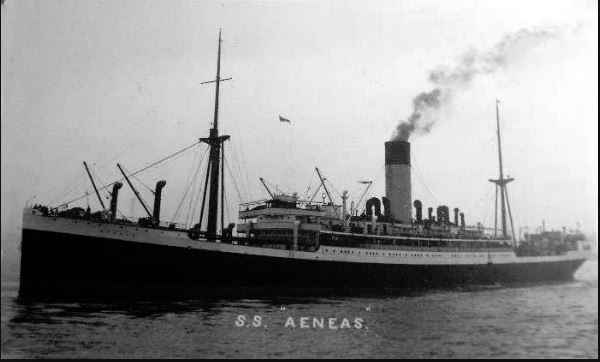
On reviewing military records, it seems that William signed up at the same time as a number of local young men including two brothers of Raymond’s wife, Helen Morton (nee Grace) - Roy and Harold Grace. All three were allocated to the 18th Battalion (8th reinforcements) and, after initial training, embarked for Egypt on board the HMAT A6 Aeneas.
Soon after arriving in Egypt, William was hospitalised for four weeks with mumps then, in early April 1916, transferred to the 54th Battalion.
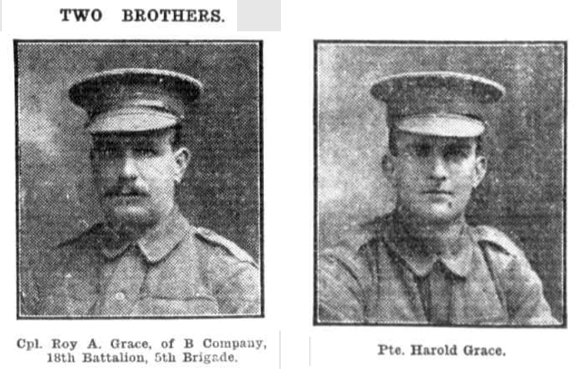
The two Grace brothers remained serving with the 18th Battalion. Roy (1881-1916) was killed in action in France in November 1916 while Harold (1892-1953) was wounded in action and returned to Australia in February 1918.
William’s neighbours and local community
The communities in the agricultural and mining areas of north-west New South Wales were closely connected by business and family ties with considerable movement between different localities. Accordingly, the sense of neighbourhood and community was much broader than just the local township. Areas such as Tambar Springs were justifiably proud of their region and their people, even more so during the war years, with local papers reporting on local lads heading for the front, their fates during the war and celebrating the ones who came home.
According to the official tourism site for New South Wales:
Tambar Springs claims to have the earliest Memorial to World War I servicemen in Australia and was erected in December 1918. In addition, Tambar Springs had the largest number of men per capita enlisted in the army in the Commonwealth, over both world wars. The Italian marble Memorial has stone columns with name plaques recording the names and rank of the district residents who volunteered for service. The iron gates to the memorial have an arch displaying the words Lest We Forget.
William Daley’s name is recorded on the plaque below the statue of the soldier standing easy with eyes downcast. The statue is life-size, made of Italian marble and reportedly cost £300, quite a feat for a small country community. The more than 90 names on the plaque are listed in the order in which they enlisted, noting those who paid the supreme sacrifice and also those awarded military honours.
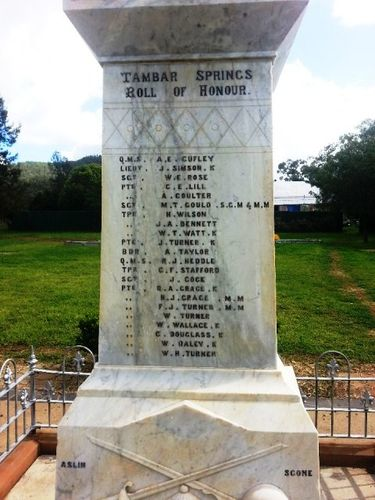
William was not the only soldier listed on the Tambar Springs memorial who was killed at Fromelles. Private Michael Balkin, also serving in the 54th Battalion, was killed in action and his name appeared on the German Death list. His remains have been identified and he is buried at the Pheasant Wood cemetery at Fromelles.
Four other soldiers from the broader Gunnedah district also died as a result of the Battle of Fromelles - Henry Saunders, Harold Ballard, Irving Thompson, and Rupert Bussell – of the 53rd, 54th, 55th and 56th Battalions respectively. All four of these soldiers are buried in identified graves in either England or France. Only William remains unidentified and without a known grave.
Mistaken identity
As an aside, it is also noted that William was inadvertently involved with two cases of mistaken identity.
The first involved an error by military authorities in advising that a different Private William Daley (from Scone in New South Wales) had also been killed on 19/20 July 1916. This dreadful news was conveyed to the family in Scone but was retracted some weeks later when it was realised that the William from Scone had not been killed but rather wounded. Both Privates William Daley – number 3636 from Tambar Springs and number 4762 from Scone - were at Fromelles with the 54th Battalion, both of a similar age and colouring. Only one survived the Battle of Fromelles, albeit wounded and eventually discharged medically unfit.
Which Private Daley?
In an article (extract below) published on the AWM website, Patricia Kennedy describes the actions of a Private Daley of the 54th Battalion but we are uncertain if this relates to the Daley of Tambar Springs or the Daley of Scone.
Each soldier was to carry 150 rounds of small arms ammunition in web equipment and an extra bandolier of 50 slung on his left shoulder. Two grenades will be issued to each man to be carried in the haversack on the right side. The 54th Battalion left their trenches to cross No-Man’s Land, immediately Private Daley and his fellow troops then came under a storm of artillery and machine gun fire.
Wave after wave made the dash across the open ground disappearing into the heavy smoke now lying over No-Man’s Land from all the shell fire. From their secure positions just on the far side of Aubers Ridge crest, the German battery crews pour fire down onto No-Man’s Land where the Australians are attempting to cross, cutting many of them to pieces. The 54th Battalion’s distance across No-Man’s Land was only 200 yards arriving at the German trenches where they fought hand-to-hand quickly killing or captur(ing) them.
Source: AWM, Patricia Kennedy article
The second case of mistaken identity arose whereby a grave at the ANZAC cemetery at Sailly-sur-la-Lys cemetery in France was originally marked with 3636 Private William Daley’s details but later amended to that of 184 Private Leslie Richmond Daly (31st Battalion). It appeared to have been a clerical error with evidence that the soldier buried there was actually Private Leslie Daly from Ballina who had also died 20 July 1916, probably also at Fromelles. Research at that time could find no trace of where William had been buried.
The sad indignities – although unintentional - of these further errors add poignancy to William’s story and encourage us to further our efforts to identify where he now lies and to give him the honour and dignity he deserves.
DNA is still being sought for family connections to
| Soldier | William DALEY 1887-1916, Glen Innes, NSW |
| Parents | |||
| Peter (Paddy) DALY 1840-87 – from England or Ireland (Y DNA line)and Ellen HARRISON born abt 1850s at Wellingrove, died 1912 at Tingha from New South Wales (Mt DNA line – indigenous) | |||
| Grandparents | |||
| Paternal | Unknown – Likely England or Ireland | ||
| Maternal | Henry HARRISON 1816-1913 – born Warwickshire, Eng and Kate / Lena ROBINSON 1830-68 (Mt DNA line - indigenous) |
Sources for information on William Daley’s indigenous heritage include:
Indigenous histories website – see Posting 15 June 2017 Additions to list of aboriginal WW1 AIF volunteers
- Kate Waters, Bullcorronda (Mount Yarrowyck) - Aboriginal Cultural Association with Mount Yarrowyck Nature Reserve, [2016, Office of the Registrar, Aboriginal Land Rights Act 1983 (NSW)] – see page 119 for details of the Harrison/Robinson families.
- Centre for indigenous family history studies website – see NSW records Nucoorilma - Genealogies (Tingha)
- Inverell Reconciliation Group – contact details on the “Come on Inland” website for the Regional Development Australia Northern Inland (RDANI) – see Inverell Shire: Lifestyle
The Fromelles Association would love to hear from you

Contacts
(Contact: royce@fromelles.info or geoffrey@fromelles.info).
(Contact: army.uwc@defence.gov.au or phone 1800 019 090).
Donations
If you are able, please contribute to the upkeep of this resource.
(Contact: bill@fromelles.info ).

